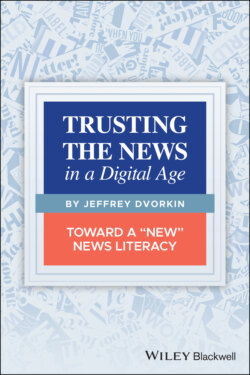Читать книгу Trusting the News in a Digital Age - Jeffrey Dvorkin - Страница 24
News and Digital Culture
ОглавлениеLegacy media organizations, such as The Guardian, The New York Times, and NPR, are feeling the effect from the blogosphere by heightening their online and podcasting presence; online journalists, often encouraged by media managers and the public, are feeling more empowered than ever. High‐profile activists such as Wikileaks' Julian Assange and The Intercept's Glenn Greenwald, among many others, use the digital environment to great, if often controversial effect. Mainstream news organizations such as the New York Times, The Washington Post and The Guardian were early, eager collaborators, even if they now demonstrate a certain “buyer’s remorse” at the lack of journalistic accountability shown by some of their newer contributors.
In this changing environment, the news is still able to insist that it operates as a civic model for the benefit of society overall. But it has found it more difficult to function economically. There is a sense of abandonment by the public, still felt in executive offices. In the pre‐digital era, news organizations competed with one another. Now, and with a reduced workforce, they are competing with the multi‐dimensional Web, against all of the powers that the Internet can bring to the fight.
As a result, the Internet is proving to be a vibrant, nimble, often destabilizing and highly competitive presence. This is especially true when it comes to the preference for political satire and comedy, especially among younger consumers of information who enjoy the more raucous and outrageous. The appeal of authoritative and trusted news has been undermined by the powerful entertainment values of the digital culture. And not just in the English‐speaking world; in times like these, the rise of ubiquitous mockery (such as Charlie Hebdo and The Onion) is an indicator that the old approaches are insufficient, especially for younger media consumers.
In the mid‐2000s, mainstream news organizations had a haughty disregard for bloggers. But as the advertising model for traditional news organizations began to collapse and non‐traditional media began to attract larger audiences, news organizations rushed to embrace digital technology. They hoped to connect with its promise of larger (and younger) audiences. But those new audiences have not returned the eager courtship in quite the same way.
Audiences are still fragmenting, and news organizations are increasingly on the defensive when the blogosphere and partisan media accuse mainstream news of bias. However, we may now be seeing a reversal of fortunes as mainstream media organizations in North America and Europe replace old‐style advertising revenue with paid subscriptions delivered online (along with supportive banner advertising).
In 2004, Alan Rusbridger, the former editor‐in‐chief of The Guardian, predicted that online revenue would eventually surpass print advertising for all newspapers. This prediction became known as the “Rusbridger Cross.” He seems to have been proven correct. The New York Times now makes considerably more money from its online subscriptions than from advertising. But it has done this by providing a higher quality of information, especially when combined with powerful and contextual visual presentations.
Alan Rusbridger.
Source: The Guardian.
